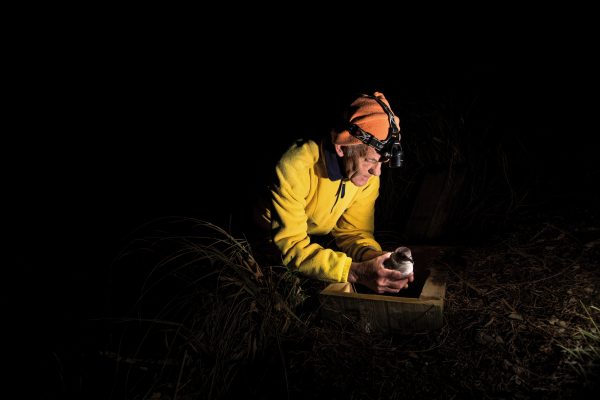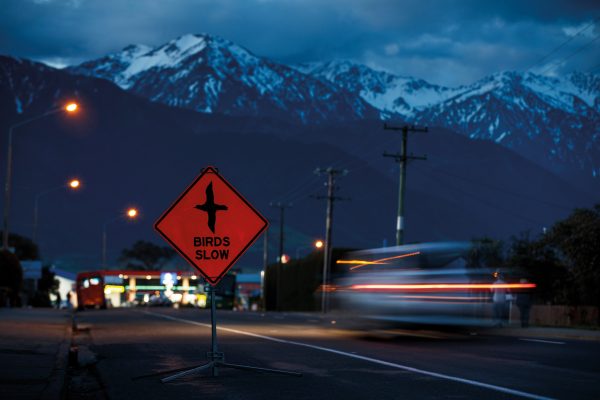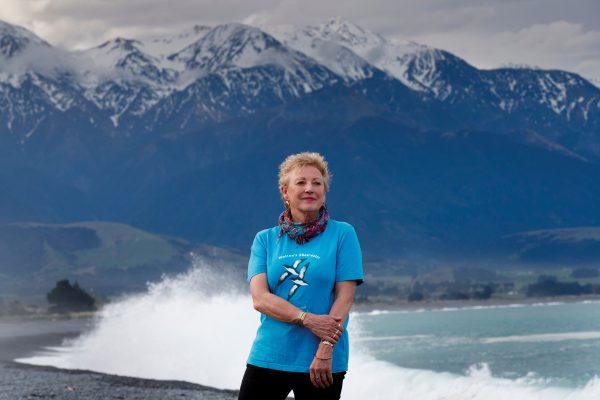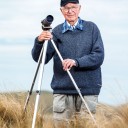
Snow birds
No one knew that Kaikōura was home to the world’s only alpine-dwelling seabird until an amateur ornithologist following a rumour discovered its burrows high in the mountains. As the bizarre attributes and tenuous existence of the Hutton’s shearwater slowly came to light, Kaikōura took up the mantle of protecting its local bird—just in time to witness the destruction of its breeding grounds in the November 2016 earthquake.

The sun set a couple of hours ago. Tucked into a fold of the Seaward Kaikōuras, in a bare scree-covered valley where late snow still lingers, a hundred thousand seabirds are arriving home for the night.
Above me, little white-breasted bodies sail towards the valley face. There’s no sound except the soft crunching of footfalls in the snow as they land.
One shearwater drops into the snow beside me, shakes its head and takes a moment to collect itself. Its plumage is the colour of an imminent storm or a suit that a man might wear to a job interview. There’s a velour-like texture to its feathers.
Then it wanders off towards a tussock, ducking underneath the long fronds and vanishing into the side of the mountain.
Something hits me gently in the side of the head and tumbles to my feet. Another one. It’s like being strafed by marshmallows.
At the beginning of September, half a million Hutton’s shearwaters returned from their winter in the Timor Sea off Darwin, trading warm coastal waters for snow-covered scree. Most flew home via the Indian Ocean, their migratory path a circumnavigation of Australia.
Whale-watchers and fishers were the first to see the birds, which mass in rafts on the water by day to feed. For decades, the sea was the only place most people saw Hutton’s. But there were a few stories about birds that lived above the bushline. Shearwater chicks, or tītī, had once been an important food source for Ngāti Kuri, while hunters reported rabbit-like burrows high in the ranges.


When Geoff Harrow, an amateur ornithologist from Christchurch, began asking around Kaikōura if he could find sooty shearwaters nesting on the coast, he was astonished to be told that they were up in the snow. He wondered if this was the little-known Hutton’s shearwater, a bird whose breeding habits were unknown. An Australian naturalist had described it in 1912, naming it after a University of Canterbury biology professor, Frederick Hutton. (Hutton probably never met a Hutton’s; he was dead.) Its entry in Harrow’s bird book was frustratingly vague.
Harrow, a pharmaceutical salesman by trade, is sunny and affable. He’s the sort of person who trusts in the kindness of strangers, has difficulty seeing anything as insurmountable, and describes a 12-hour tramp as an ideal Saturday. The mystery of the snow birds was exactly the type of challenge he relished.
On a misty February morning in 1965, following a goat-culler’s tip, he set off up the Kōwhai River. By nightfall, he’d climbed about 1400 metres, and the fog was still as thick as pea soup.
Harrow listened intently for the sound of shearwaters returning from the sea. He heard quite a few goats. A kea or two. By daybreak, exhausted and demoralised, he began to wonder if the rumours were just rumours after all.
Then, following a steep deer track downhill, he stumbled on the maggoty corpse of a bird. It definitely wasn’t a kea. Further along, he found two more carcasses, and a hill riddled with empty burrows. He shouted for joy, the sound echoing off the steep bluffs. Then he stuffed the bodies into a flour sack for the long walk out.
After showing his smelly discoveries to his wife and nephew, Harrow posted the birds, maggots and all, to Robert Falla, the director of Wellington’s Dominion Museum. A couple of days later, a telegram from Falla arrived: “Your specimens are all Puffinus huttoni.”
Harrow was now the only person in the world who knew where Hutton’s nested. He set out to learn more, combing every high river valley and basin in the Seaward and Inland Kaikōuras for colonies. The search consumed him. He’d drive up the coast from Christchurch after work on Friday, sleep in his car, spend a long Saturday wandering the ranges. He found more colonies at the northern end, eight in total, including one on private land at Puhi Peaks Station—only four hours’ tramp from the road end compared to the Kōwhai Valley’s eight hours, but located on particularly unstable terrain.
Harrow began writing up his observations for the bird journal Notornis, hoping to attract others to study the Hutton’s.
“I’m not an ornithologist,” he’s quick to say. “I’m not a scientist.”
Prospective students, however, were discouraged by the difficult terrain, and the Wildlife Service didn’t have funds for this sort of thing. Harrow kept visiting the Hutton’s, and so he noticed when the colonies began to disappear. Thirty years later, there were only two left.
[Chapter Break]
The sound of chattering rises as thousands of birds land in the Kōwhai Valley. All around us there are shearwaters giggling at some private joke.
Birds that haven’t paired up are prospecting for burrows. They’ll wander into likely-looking homes and wait to see if another bird arrives at the door to put up a fight. Other birds are tidying up, clearing grass and dirt from the entrances. When a burrow has been occupied, it looks as though its front doorstep has been swept.

Some shearwaters have found mates already, but their homes are still buried, so they sit on the snow in pairs, waiting for the entrances to their burrows to melt.
Amidst the tussock and Celmisia festooning the valley face, there’s the occasional knob of dirt worn smooth: the local diving board. Hutton’s cannot take off from land. On the water, they run along the surface to get going; here, they need something to leap from, and the whole colony favours the same spots.
“You’ll see them scurry along to a good liftoff place,” says Department of Conservation ranger Mike Morrissey. “The preferred takeoff places are grassy at the start of the season, but towards the end, they’re all quite bare.”
Hutton’s arrive home late and leave early. At five o’clock in the morning, the air above us is full of soft babbles and giggles and clucks. It’s well before dawn, too dark to see the birds circling overhead. Morrissey says they’ll whirl round and round for a bit, whipping themselves into a frenzy, and then, at some invisible signal, depart.
I imagine the shearwaters streaming down the valley, a squadron of thousands of little bodies, veering east towards the ocean across the patchwork of farms and plunging down, down, down to the sea. Their bellies are the colour of cloud, and no one in the fields or the town will see them passing over.

It’ll take the fastest ones just seven minutes to reach the water—they’ve been clocked flying at more than 150 kilometres per hour. They’ll land in a great flock somewhere along the coast, anywhere between Cape Campbell and Banks Peninsula.
We find them, a few hours later, in South Bay, a half-moon of water held between the open arms of the Kaikōura peninsula and coast. Clustered in the curve of the beach is a great raft of thousands of Hutton’s, wheeling and plunging into the water.
As we approach the vortex, it assumes a sort of order: the birds are whirling anticlockwise, diving into its centre, popping out at the edge like corks, shuffling their feathers and taking off again.
Everywhere there’s the noise of Hutton’s running on the surface of the water, a child-in-a-puddle sound, splish-splosh-splish-splosh. Flying looks harder for them than other birds. When one takes off, it steps up onto the surface of the water and begins to run in a perfectly straight line, legs extended front and back in the splits like a gymnast on a balance beam. It always looks as though it’s straining hard, like it won’t make it, then all of a sudden the air holds it up and it’s gliding over the surface of the water.
It’s hard to believe that a crowd of birds this big ever went unnoticed. But seabirds weren’t something that got noticed back in the day. Kaikōura’s main industry was fish, and then whales, and people were more concerned with what was in the sea than what was on top of it.
“You’d see seabirds but you hardly knew their names,” says Dennis Buurman, who was a crayfisher for more than a decade before establishing a dolphin-tour business, Encounter Kaikōura. “We just vaguely knew that some were albatrosses and some were petrels and that was about it. We didn’t even know shearwaters.”
When one of Buurman’s skippers, Gary Melville, told him birdwatching was a serious hobby and there were people who specifically wanted to go and look at seabirds, Buurman took notice.
“That’s how this birdwatching thing started. We had a spare boat. I went out with Gary quite a lot and he helped me identify all these different birds, so I got quite good even from a distance. Just by the way they fly.”
Shearwaters skim the surface of the water as though daring each other to see how close they can get without touching it—unlike gulls, which fly higher. To feed, shearwaters dive into the water, while terns, which are about the same size, swoop and pluck fish from the surface.
Hutton’s shearwaters may be numerous—about 120,000 breeding pairs, and half a million birds in total—but they’re classed as nationally endangered.
Geoff Harrow has borne witness to how quickly hundreds of thousands of Hutton’s can be wiped out. Their predators, mainly wild pigs, have encroached gradually higher and higher in the mountains. The two surviving colonies are the most inaccessible ones, but Harrow and DOC knew they wouldn’t always remain out of range. The only solution was to start a new one, an insurance colony, somewhere that wasn’t several hours’ walk into the mountains, somewhere easier to protect.
[Chapter Break]
Lindsay Rowe reaches into a burrow and extracts a squirming shearwater that has bits of straw stuck to its feathers.
“You’re a bit scruffy, aren’t you?”
Below him, burrows fan out all the way down to the cliffs of the Kaikōura peninsula. These ones weren’t dug by shearwaters, but made by volunteers out of wood or concrete. They have short tubes of spouting as entrances, and lids, allowing Rowe to monitor the locals’ comings and goings. There aren’t usually birds inside during the day: “At this time of year, we find the odd one,” he says.
Rowe weighs the bird and writes down the number on its band, 16934. He can’t quite keep its hooked beak away from his hands, and it slashes him across the knuckles, but he’s unperturbed, almost affectionate. It’s a chick that was translocated here in 2008; its return is a sign of the artificial colony’s ongoing success.
A retired hydrologist and a full-time appreciator of birds, Rowe is the peninsula colony’s unofficial caretaker. When he was growing up in Rangiora, his father, a plumber, held a licence to band birds; Rowe and his dad would put a metal tag on a gull or a shearwater and wait to see where it turned up next. A sooty shearwater they banded was later recorded off the coast of Washington State, a Hutton’s that Geoff Harrow brought them was sighted on the Albany coast of southwest Australia.
Rowe was one of the volunteers to take on parenting duties when chicks were translocated from mountain colonies to the peninsula. He fed them sardine smoothies for weeks until they fledged, hoping that the homing instinct deep within them would set itself to the peninsula rather than the mountains. It was a long wait to find out if it did—young Hutton’s spend three years abroad before returning to New Zealand to breed. The first translocated chick returned to the peninsula in 2008.

“It’s the perfect place for them to come to,” says Rowe. “The bluff here, there’s always a breeze. They can go to the top and take off, it’s got the steepness.”
But the new colony was struggling for a different reason. An unsuccessful fence of chicken wire and fishing net separated it from the mainland, and despite Mike Morrissey being on cat patrol around the perimeter, the birds within were dying.
[sidebar-1]
DOC couldn’t afford to do anything about it. For Geoff Harrow, this was a turning point: the future of the Hutton’s clearly depended not on the government but on the community. And the community needed something to rally around. Gathering a group of people who’d already put a lot of effort into the birds, Harrow created the Hutton’s Shearwater Charitable Trust.
Rowe, whose submissions to Notornis were often criticised for being “too colloquial”, discovered a talent for writing letters to solicit funding. In a year, the trust raised $250,000 for a predator-proof fence, and the following summer, the peninsula colony’s first egg hatched.
Today, there are just two Hutton’s that stayed home, and Rowe quickly finishes his rounds. He’s been doing this for more than a decade. The air is thick with held-back rain, and the breeze blowing off the land is so warm and redolent you could almost slice and eat it. In the distance, the clouds come in and begin to erase the mountains. It’s the type of weather that confuses the inner compass of young Hutton’s.
[Chapter Break]
From March to April, newly fledged Hutton’s make their first flights down to the sea, and that’s where things go awry. Fog or the glow of the lights in town confuse them, they crash-land, and because they can’t take off from flat ground, they get stuck. The waterfront promenade is a particularly popular area for crash-landings. Perhaps it’s the colonnade of Norfolk pines. Perhaps the young birds just misjudge where the sea is. Perhaps, when it rains, the slick black asphalt looks like the surface of the water.
For the trust, this was an opportunity to mobilise Kaikōura. Nicky McArthur, who owns Puhi Peaks, had always wanted to bring the town and the bird closer together, and she brought Olympic-level determination to the task.
Knowing the bird needed champions, she decided to create them, correctly anticipating that the most effective way to disseminate information within a community was to give it to children as homework. She set up a Hutton’s education programme that now runs in local schools, and started a series of public events: a celebration to welcome the birds in the spring, and a farewell ceremony in autumn. At the end of Kaikōura’s main road hangs a banner she had made, the type you’d see at a school gala: ‘WELCOME HOME TĪTĪ’. No longer will the shearwaters lead invisible lives if McArthur has anything to do with it.
“People cross the street to avoid me,” she says, kind of chuffed about it. “They say, ‘Here comes Mrs Hutton’!”
March in Kaikōura has become ‘Fly Safe Month’. Shearwater warning signs go up on the streets. Locals are implored to switch outside lights off, keep cats inside, drive carefully on foggy mornings. There’s a proposal in front of the council for hooded streetlights that cause less light pollution.


The local DOC office has a shed around the side, a ‘Hutton’s Hub’ where stranded birds can be dropped off, to be later released on the water. It’s pretty cute: a row of nest boxes with lids that can be lowered when a bird is placed inside.
“There are people who will go out at night and do a certain beat and they’ll drive around at 10 or 11 o’clock,” says Dennis Buurman. “Some of them do it two or three times a night. Just people who feel that they’d like to help. They don’t like to see the birds squashed on the road.”
An ongoing study of crash-landed Hutton’s, sponsored by locals, uses data gathered by the public and processed by high-school statistics students. A biology class was recruited to DNA-test the fledglings, looking for links between gender, morphology and bad navigational skills.
In 2016, about 70 crash-landed Hutton’s were rescued. The year before, it was 200. Admittedly, this isn’t much out of a population of hundreds of thousands. It probably wouldn’t make a difference if the cats got them.
But what Harrow and McArthur and the trust recognise is that most people don’t get to take part in the care of anything fragile. The work of saving things goes on around us as invisibly as the dawn flight of the Hutton’s.
Looking out for little birds on the road means that people are looking out in the first place, that they’ve started to notice a world that’s not their own. To recognise a shearwater and pick it up and put it in a box is to exercise a muscle of care for something outside the human realm. Perhaps, after all, it’s worth saving one of a hundred thousand shearwaters, granting it another chance to race down the ranges to the sea, just as the stars are fading out, for breakfast.
















